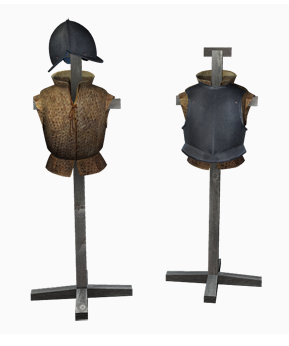Object Descriptions Tower House Storage Room and Armory
Quilted jack, and “checklaton”
Spenser was known for his experience in several wars. His reputation in this regard helped secure him the nomination of Sheriff of Cork soon before his death. The Munster planters were responsible, in part, for their own security, including supplying able-bodied men and equipment for militias in time of need. Many weapons would have been stored in secure levels of a tower house, including areas like this one between main floors.
Literary Connections
This particular item, a “quilted leather jack,” Spenser describes as an English type of protective garment used by the Irish in his View of the Present State of Ireland (c. 1596).
In the same passage in the View, the speaker Irenius confusingly compares it to “Checklaton,” a costly article of clothing worn by the character Sir Thopas in Chaucer’s Canterbury Tales. In The Faerie Queene, the fierce character Disdayne appears in a quilted jacket and checklaton:

He wore no armour, ne for none did care,
As no whit dreading any liuing wight;
But in a Iacket quilted richly rare,
Vpon checklaton he was straungely dight,
And on his head a roll of linnen plight,
Like to the Mores of Malaber he wore;
With which his locks, as blacke as pitchy night,
Were bound about, and voyded from before,
And in his hand a mighty yron club he bore. (The Faerie Queene VI.vii.43)
Disdayne wears a turban, like the “Mores of Malaber,” thus making him into a middle-eastern threat as much as an Irish one. There may be yet further confusion intended by Spenser: O’More is an Irish name, and Irish women (if not men) wore turban-like linen wraps on their heads in Spenser’s day.
Bibliography:
Rudolf Gottfried (ed.), Spenser’s Prose Works. The Works of Edmund Spenser: A Variorum Edition. Vol. 10 (Baltimore: Johns Hopkins Press, 1949): 121, 352-3.
Andrew Hadfield, Edmund Spenser: A Life (Oxford: Oxford UP, 2012): 201, 220.
Carol Kaske, “The Word ’Checklaton’ and the Authorship of A Vewe of the Present State of Ireland.“ Spenser Studies 13 (1999), 267.
Paul Piehler, “Disdain.” The Spenser Encyclopedia. Ed. A. C. Hamilton (Toronto: University of Toronto Press, 1990), 220.